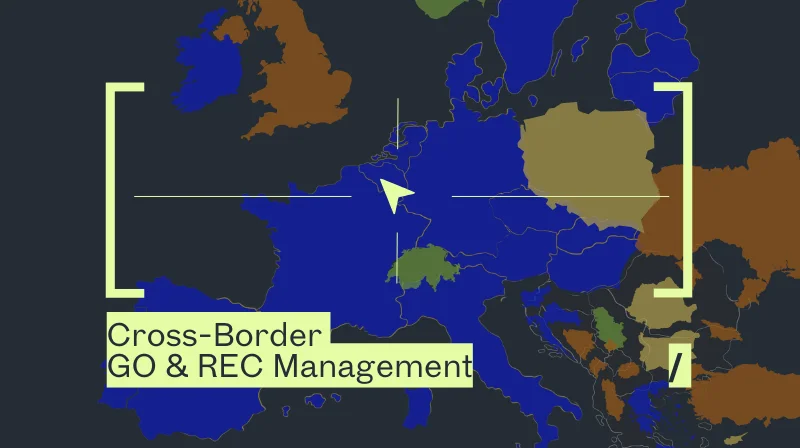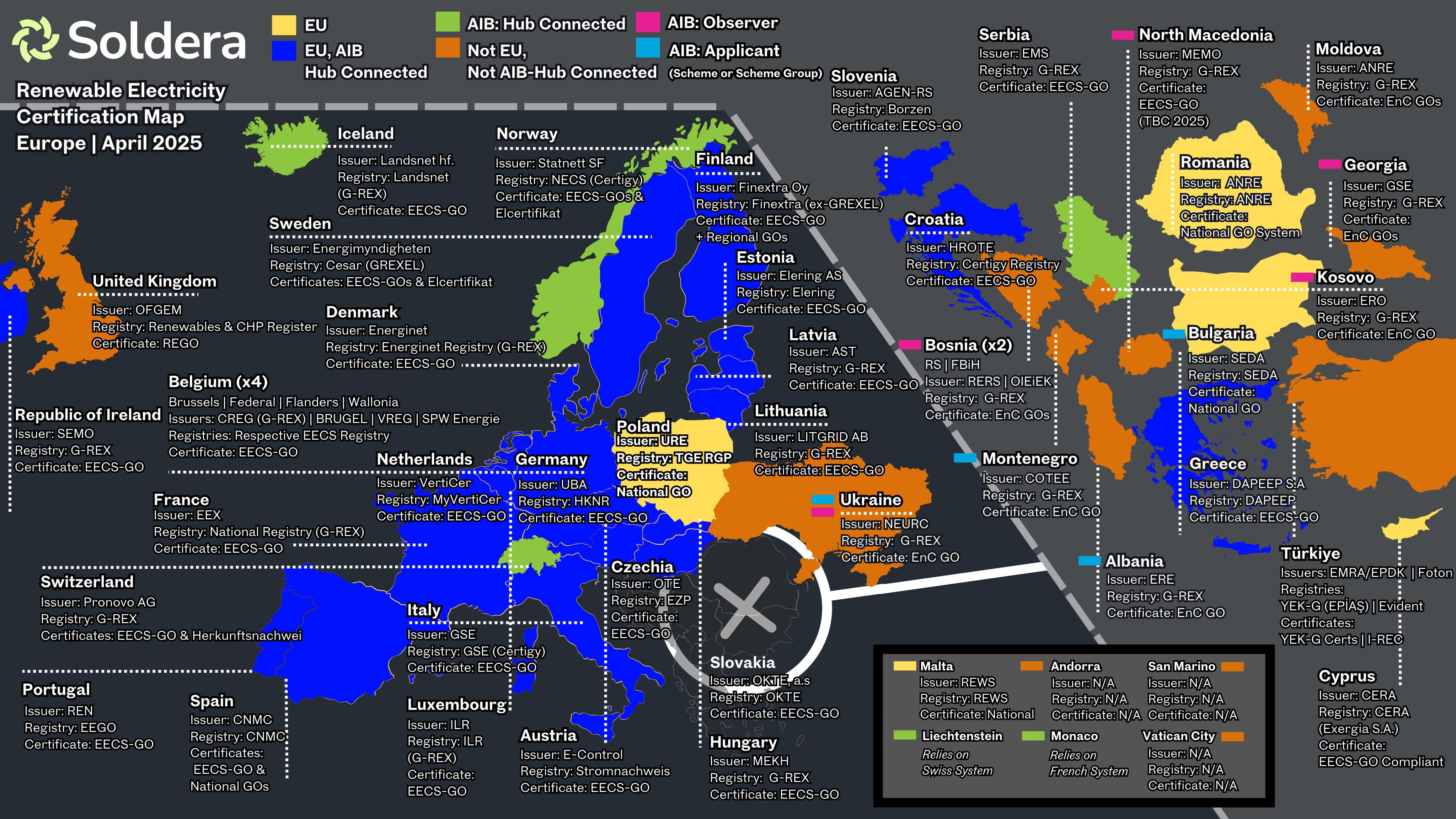

The Guide to Cross-Border GO & REC Management in 2025
The Guarantee of Origin (GO) market can be a complex web to navigate. It’s possible you are looking to source and interact with GOs from more than one country. Or, your company owns renewable production assets around the world. You might also be a GO trader handling international transfers. Either way, you probably want to access your portfolio in one consolidated place. Well, take it from us— unless you've got a lot of spare time to start building this tool yourself, you need a fast, existing solution, because the landscape is incredibly fragmented.
So, we need to be honest. Unless you need convincing about the scale of the problem— we only know of one catch-all solution, and that’s Soldera. However, we did promise you article, so first, let's look at exactly why this is such a pain. Feel free to skip to our solution at the end if you aren’t interested in the details!

Why is managing GOs and RECs still this fragmented in 2025?
Despite years of policy and market design efforts, renewable energy certificate systems across Europe remain structurally divided. What really should be a pan-European solution to verifying clean energy usage continues to operate with national and regional differences. We’re talking 30+ logins, different operating protocols, and application processes.
Obviously, countries differ in terms of political affiliation with the EU, but even EU membership doesn’t guarantee or indicate an AIB membership by default. In addition, the extent to which their registries are technically interoperable (usually understood as whether there is a connection to the AIB “Hub”) is a separate issue altogether. As a side note, this map also doesn't include quality and attribute labels that can be added to GOs. We have an article coming out on those very soon, so keep an eye out for that if you want to learn about another quirk of the GO market!
Anyways, let’s get back to the basics. As of 2025, buyers and sellers must still navigate, at a high-level, four overlapping categories of GO jurisdiction:
- EU member states
- EU member states that are AIB Hub Connected
- non-EU member states that are AIB Hub Connected
- countries that are neither EU member states nor AIB-Hub Connected
These distinctions directly shape which certificates can be issued, transferred, and cancelled. But even in EU, AIB-Hub connected nations, inconsistencies surrounding these actions arise— further regional specifics are visible on the AIB “imposed conditions” survey results page. You can also view the fees, also inconsistent between AIB member registries, on their list of tariffs.
Finally, if you want to stay one step ahead, you might also want to consider the existence of AIB Observers, and AIB Applicants (as applicants either to the Scheme or Scheme Group), as these will be the domains that are most likely to eventually issue EECS-GOs.
- Observer status allows countries to engage in AIB knowledge networks but offers no market access.
- Applicant status, on the other hand, triggers the legal and technical process of preparing a Domain Protocol, registering software systems, and achieving full Hub integration—a process that typically takes between six months and two years. In most instances, when a registry is connected, you will find the relevant domain protocol becomes available, tagged with “E” for electricity.
Ukraine has dual status: it is both an observer (SAEE) and an official applicant (NEURV) to the AIB's Electricity Scheme Group. Bosnia and Georgia remain observers, while Albania and Montenegro have formally entered the applicant phase.
What explains the category outliers?
Several countries occupy ambiguous or unique positions in the certificate ecosystem. Poland, Romania, and Bulgaria, for example, are the three EU member states that maintain national GO registries that operate entirely outside of the AIB Hub.
- Poland utilizes the Guarantees of Origin Register (RGP) managed by the Polish Power Exchange (TGE).
- Romania issues GOs through ANRE, the national transmission system operator.
- Bulgaria's system is overseen by the Sustainable Energy Development Agency (SEDA), with the Independent Bulgarian Energy Exchange (IBEX) facilitating market operations
While these certificates are valid domestically, they lack standard cross-border tradability (except in specific instances of agreed ex-Domain cancellations), limiting their utility internationally.
Serbia is the exact opposite - despite being a non-EU member state, it is connected to the AIB hub, and the authority EMS issues EECS-GOs. The same situation can be identified for Norway (NECS), Iceland (Landsnet), and Switzerland (Pronovo).
Cyprus is an edge case. Though an EU member, and with EECS-compliant certificates currently being issued under its national system via the CERA registry, the island remains unconnected to the AIB Hub. This is purely for technical reasons and has been planned since their 2022 domain protocol, reminding us there is occasionally a gap between technical readiness and market participation, despite adhering to EECS-GO standards already.
Norway is fully connected to the AIB Hub through Statnett SF’s NECS registry, but continues to operate its shared Elcertifikat scheme with Sweden. This is a regional system being continued for existing producers only (as it is in the process of winding down the joint scheme). This dual system is similar to Finland's approach, where Finextra issues standard EECS-GOs and Regional GOs which are managed separately and cannot be transferred to other AIB member countries.
Why do some countries have multiple issuers?
One of the most confusing aspects of the European certificate landscape is the prevalence of multiple issuers within single countries. Belgium, for instance, exemplifies this complexity with four distinct issuers: CREG handling federal matters (through G-REX), while BRUGEL, VREG, and SPW Energie manage Brussels, Flanders, and Wallonia respectively. Each operates its own EECS Registry, requiring market participants to navigate multiple accounts and processes.
Bosnia and Herzegovina follows a similar pattern, with RERS and OIEiEK splitting responsibilities between Republika Srpska and the Federation of BiH. While both use the G-REX platform, they maintain separate issuing authorities.
Turkey presents another unique scenario, operating both the national YEK-G scheme through EMRA using EPİAŞ's registry, whilst simultaneously allowing voluntary I-REC issuance (the only country in the continent that does) via Foton on the Evident platform. This means there are parallel certificate systems within the same country, each with different recognition, tracking and redemption methodologies, and compliance value.
What role does the Energy Community play and who's already aligned?
The Energy Community (EnC) acts as somewhat of a a bridge between non-EU countries and the EU's energy market framework. Only certain EnC members issue EECS-GOs and have an AIB-Hub connection (Serbia, Croatia & Greece— Greece being a result of EU membership). Regardless, the EnC has enabled Albania, North Macedonia, Georgia, Ukraine, Montenegro, Kosovo, Moldova, and Bosnia and Herzegovina to develop systems that mirror EECS structures, critically, via the shared G-REX registry platform, occasionally referred to as “EnC GOs”.
The ultimate goal is clearly full integration with AIB and EECS standards. When GREXEL won the right to build these registries, they didn't hide their intentions to create an AIB-compatible system. As they stated: "The idea of the project was never to re-invent the wheel, but to adopt the existing standards, processes and technical implementations that AIB has carefully created and fine-tuned over the past 20 years.
Some countries already accept non-EECS GO imports from EnC countries via mutual agreement, but these cannot be accepted for disclosures. There is a roadmap unfolding for EnC GOs to become readily accepted.
Registry Platforms Matter: The G-REX Dominance
Looking across the European landscape, a striking pattern emerges: the G-REX registry platform has become a widely used technical infrastructure, totalling ~21 deployments in the continent. Alongside all of the Energy Community member states, G-REX powers systems in Ireland (SEMO), France (EEX), Denmark (Energinet), Belgium (CREG), Iceland (Landsnet), Luxembourg (ILR), Hungary (MEKH), Latvia (AST), Lithuania (LITGRID).
GREXEL have been a key player in the registry scene for a while, with Custom Grexel systems operating in Sweden (Cesar by Energimyndigheten) and formerly in Finland before Finextra took over in 2015. Some bespoke non-GREXEL systems remain in place for Germany (HKNR), Spain (CNMC), and Poland (TGE RGP), whilst Certigy-based registries are used in Italy (GSE), Norway (NECS), and Croatia (HROTE).
The Micronations: Small States with Unique Approaches
Europe's microstates present their own peculiarities. Malta maintains its independent national registry through REWS. Liechtenstein and Monaco rely on Swiss and French infrastructures, respectively. Andorra, San Marino, and Vatican City have yet to formalize GO systems, creating gaps in renewable verification. These micronation cases highlight that physical interconnection and political relationships often shape certificate systems more than pure market design.
How does Soldera solve this mess, for free?
As promised, a final solution to that headache.
At Soldera, we've streamlined every jurisdiction into our free back-office platform designed to unify the GO and REC landscape across borders, schemes, and registries.
From the outset, we've built the system architecture to be able to adapt to regional complexities, supporting registry-specific processes, and scaling with your renewable energy production or procurement strategy. Certificate complexity becomes manageable, and your EAC portfolio becomes visible, actionable, and profitable from one central interface.
You can register devices, enable automated monthly issuance, manage your inventory and device status, handle transactions, access consolidated reporting, obtain ecolabel approval, and view our quarterly GO market outlooks—without paying a cent for software. For those using our aggregated market channels, you'll also get KYCs, contracting, invoices, transactions, and complete transaction history included at no additional cost. That's because we earn only from successful GO transactions, so everything else is yours to use freely, ensuring our interests are aligned.




